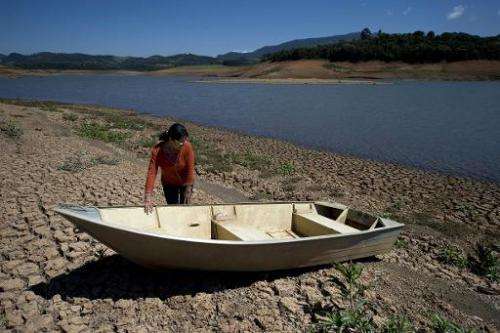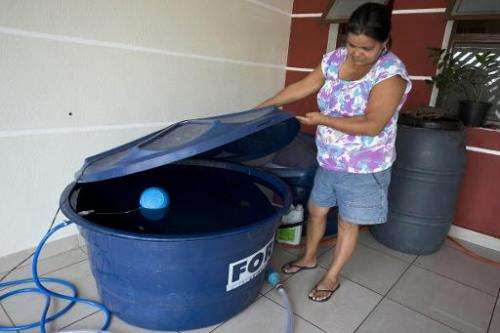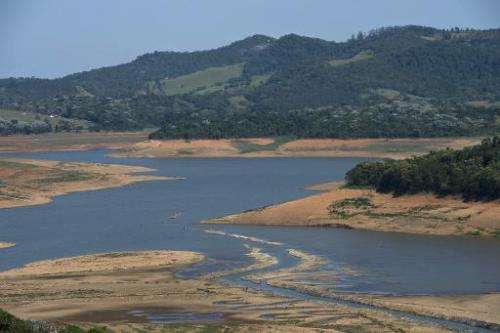Sao Paulo drought issue for global concern

He cast his rod happily here for 30 years—but where a river once teemed with fish, Brazilian fisherman Ernane da Silva these days stares out over a valley of weeds and bone dry, sun-parched land.
The southeastern state of Sao Paulo is suffering its worst drought in 80 years with scores of towns sounding the alarm, blaming increasing deforestation, unseasonably high temperatures and creeping urbanization.
"I was one of the first fishermen to arrive here and today I am one of the last still here," says Da Silva, 60, standing by the Jacarei dam 110 kilometers (70 miles) outside Sao Paulo.
"I have been fishing here for 30 years. How could I ever have imagined there would one day be no more water?" he asks incredulously.
The problem of severe drought affects millions of inhabitants of Brazil's most populous and developed region.
Sporting a cap against the blazing sun, Da Silva says he has abandoned his home by the banks of the Jacarei River, part of Sao Paulo's Cantareira system of five dams built in the 1970s supplying water to 45 percent of the metropolitan region of 20 million people.
This year has forced him to fish further upriver where water levels are higher.
But he has no idea if that will be possible next year with water levels having already hit an historic low.
Bad management
October to March rainfall in the area was insufficient and in November dropped to 90 millimeters, well short of the average 161.2 millimeters.
"The lack of rainfall was especially severe this year, accompanied by high temperatures in winter as well as in summer, speeding up evaporation of the dams," meteorologist Marcelo Schneider told AFP.
"Unlike previous droughts, both the population and demand for water were higher,".

Sao Paulo, Brazil's economic powerhouse, suffered a serious drought in 2001 and also at the start of the 1960s.
Although the economic fallout from the current crisis has yet to be calculated experts warn the supply system faces collapse and say drought is not merely a climate issue.
"It is important to know if we are ready or not to confront it," Maria Assuncao Silva, from Sao Paulo University's Department of Atmospheric Sciences, told AFP.
Experts point to a lack of investment and infrastructure as well as failure to stock water in years of more plentiful supply.
They add that demand for supplies from Cantareira is now overwhelming the system and also blame poor management.
In the meantime, residents from central Sao Paulo right out to the fringes of the giant city are increasingly up in arms over periodic supply cuts.
Sao Paulo's biggest water company Sabesp says rationing is not necessary, a view shared by freshly re-elected governor Geraldo Alckmin, who has announced construction of a water recycling plant as well as new supply reservoirs.
But some of the state's 40 million population have already suffered rationing in areas where Sabesp does not operate.
Global imbalance

Some experts blame an upturn in deforestation as a key factor behind the drought.
"The exceptional drought that southeastern Brazil, especially Sao Paulo, is suffering could be the result of the destruction of Amazonia," says Antonio Donato Nobre, a researcher with Brazil' National Institute of Space Research (INPE).
"Amazonia exports humidity and brings rain to the southeast, the center-west and south of Brazil but also other regions of Bolivia, Paraguay and Argentina across thousands of kilometers," Nobre told AFP.
Anicia Pio, of the Sao Paulo Federation of Industry (FIESP), says "the region is facing its worst ever crisis. This year the rainfall levels are well down on those of last year which were already critical.
"If it doesn't rain in 2015 we could have a really serious crisis on our hands. It is essential to reduce consumption as much as possible—every drop of water is important."
Scientists stress that heavy Asia-Pacific rainfall, rising ocean temperatures and drought in California are all inter-connected and part of the same global climactic imbalance.
Ever-growing, concrete-laden cities and their lack of vegetation only add to the problem.
"This drought has changed my life," laments Da Silva.
"Here, there were plenty of people fishing, swimming, having a good time. Now, there's nothing left—there's nobody."
© 2014 AFP



















